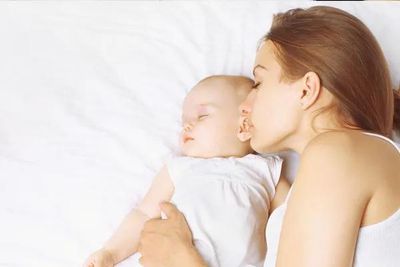For the 40 weeks of pregnancy, you and your baby were inseparable. Now that she's finally arrived, it's only natural you want to stay as close to her as possible, even when you're both sleeping.
Before deciding to co-sleep with your baby, you should know that the American Academy of Pediatrics (AAP) recommends against sharing a bed with a child under the age of 2, citing an increased risk of death from suffocation, SIDS (sudden infant death syndrome), strangulation or other unexplained causes. That said, it is a personal choice. If you do decide to co-sleep with your baby, there are precautions you can take that may allow you to safety sleep with her.
11 guidelines for co-sleeping with an infant:
Never leave your baby unattended. If your little one is sleeping in an adult bed, there needs to be an adult present. Chances are you won't always be going to bed when your baby does, so place your baby in a crib or bassinet until you're ready to join her in bed for the evening.
Place your baby to sleep on her back. The "back to sleep" practice still applies in co-sleeping situations. Experts say babies who sleep on their backs have a reduced risk of SIDS.
Skip the blanket. Both you and your baby should be dressed warmly enough that you do not need a blanket. Blankets, duvets, pillows and other bedding pose a suffocation risk to your baby. If you truly can't sleep without a blanket, use a light sheet and only pull it up to your waist.
Wear simple clothing to bed. Avoid pajamas with strings or ribbons and take off jewelry before getting into bed. If an earring or bracelet charm were to fall off, it could pose a choking risk.
Make sure your mattress is firm. It's not safe for your baby to sleep on a waterbed, an egg-crate mattress, a couch, an armchair or any other surface that's not firm and could interfere with her breathing.
Use a bedrail or have your mattress on the floor. If you place your mattress on the floor and your baby rolls off, she won't have far to fall. Rugs or pillows on the floor around the mattress can also help cushion falls. Or, you can equip your bed with a railing. Use mesh rails, not rails with slats that could entrap a baby's head.
Check for gaps or crevices. If your mattress is against a wall or anything else, check daily to make sure there are no gaps that your baby could slip into. Fill any gaps with tightly rolled towels.
Position your bed away from hazardous room features. Keep an eye out for window blind cords, lamps that can be pulled over, picture frames and other items within close reach of the bed.
No pets allowed. Don't let the bed get too crowded. Family animals should not be invited to family sleepovers.
Never go to bed under the influence of alcohol. It is very important to ensure nothing is impairing your ability to sense your baby's presence in bed. Even one glass of wine can affect you, so make it habit to never drink before bedtime.
Do not smoke. Smoking poses a significant risk for your baby to develop asthma and even SIDS. No one should ever smoke in the room where the baby sleeps.
If all of this makes you too nervous and you know won't get a good night's sleep if your baby is your bed, there are two options you can try:
A bassinet placed in the bed. If you have a big enough bed, you can place a portable infant bassinet like the Baby Delight Snuggle Nest in your bed. This may offer you a greater sense of security since there is a slight barrier between you and your baby.
A bassinet placed next to the bed. If you want to keep your baby close but don't think your bed is a good option for you and your family, you can use a co-sleeper that attaches next to your bed like the Arm's Reach Ideal Co-Sleeper. This option gives you the closeness without the bed sharing.
No matter which option you decide on, remember to always place your baby to sleep on her back. That's the number one rule for safe baby sleep.


